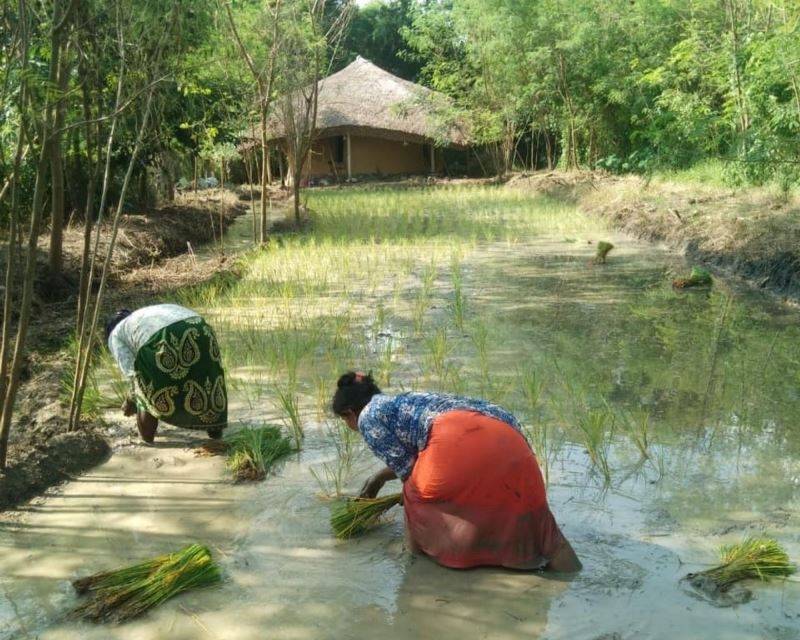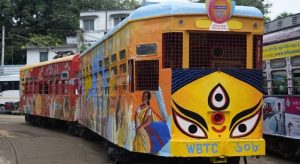The use of chemical fertilisers and pesticides directly impacted the health of farmers. Some Santalis claimed that their cattle had been falling sick and dying after eating the straw or drinking the water from local rice fields…reports Mani Mahesh Aurora…reports Mani Mahesh Aurora.
Rabindranath Tagore held the Santal tribes in special regard for their unique way of life in which they combined farming with poetry, music and dance. Spread all across rural West Bengal, the Santhals often own tiny pieces of land but largely work as daily wage labourers in rice fields.
With modern practices of rice farming draining their groundwater and making the community ill, this tribe in West Bengal is tapping into tradition to find more ‘peaceful’ ways of growing crops.
In one of their old traditional songs, ‘Har har dharti rima baha bagan; Baha bagan rima hunar Baha’, the Santhalis celebrate the green earth teeming with incredible diversity. But with the widespread adoption of modern agricultural practices, often wasteful and harmful, much of this biodiversity got lost.
In the Birbhum district, many Santhals who still forage their food have observed the disappearance of burrowing animals as well as herbaceous plants, especially in and around the rice field ecosystems. Today the Santals in Bolpur are attempting to turn back the clock; banking on traditional wisdom, with some modern scientific ideas, to reclaim some of what has been lost.

The challenge came in the form of rice cultivation ushered in with the Green Revolution, which accentuated excessive use of groundwater, chemical fertilizers and pesticides, and has led to degradation of soil biodiversity over the years. The new varieties of rice, with its shorter and weaker stalks, can’t even be used as thatching or cattle fodder.
The use of chemical fertilisers and pesticides directly impacted the health of farmers. Some Santalis claimed that their cattle had been falling sick and dying after eating the straw or drinking the water from local rice fields.
Recognising the perils of conventional rice farming, a women-led group integrated native wisdom with permaculture for a sustainable economic alternative to the way agriculture and forestry are being practised. Permaculture is the development of agricultural ecosystems intended to be sustainable and self-sufficient. The group from Khanjanpur village of Bolpur has transformed a plot of land measuring slightly less than an acre that was rendered dry with cracked soil and transformed it into a lush green ecosystem.
Their success inspired many villagers to shift to natural farming of native rice varieties that not only preserves groundwater but saves them and their future generations from having to wade through chemical-laden water in order to ensure higher yields.
Over-exploitation of groundwater
Agriculture, the way it is practised in India, is one of the major reasons for rapid groundwater depletion according to a 2016 report on groundwater status in West Bengal. Another report on water-intensive Boro rice cultivation also confirms this fact.
Recognising this, Sharmishtha Dattagupta, a former Geobiology professor from the University of Gettingen, introduced permaculture techniques to the Santhali women with the support of an Israeli permaculture consultant.

“Rice planting in the region was previously done in rhythm with nature using rainwater during monsoon. But now even policymakers promote, and governments incentivise groundwater extraction and the use of hybrid varieties of rice that can be planted in the dry winter season,” says Sharmishtha. Since the rice field needs to be flooded with water, villagers sink tube wells that draw water from up to a depth of 80 metres. This groundwater takes several years to recharge.
“Deeper underground water is rich in salts. When used in rice farming, it quickly evaporates and makes the soil salty, damaging it. Overexposure of this topsoil to direct sun as well as ploughing with tractors is devastating as it kills all bacteria, fungus, and earthworms, which play an important role in the soil ecosystem. Basically, we kill the soil ecosystem and then treat it with fertilizers and pesticides to grow food,” she adds.
(The author is a Dehradun-based freelance journalist and a member of 101Reporters.com, a pan-India network of grassroots reporters.)
ALSO READ-‘BIMSTEC a promising regional group in Bay of Bengal’






